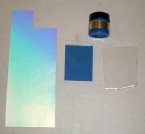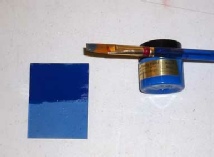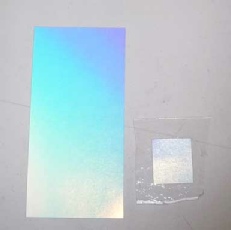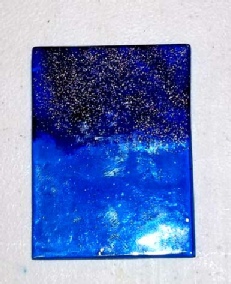
All tutorials on this site are copyright protected. They are part of a book that I am currently working on and will publish in the near future.
In order to keep our tutorials simple for this web site, we have kept the verbiage to a minimum There is a lot left up to the viewer to discover. We hope you enjoy these and find them useful.
Kaiser Glass Design
Make your own Aventurine!
 This is not an earthshaking tutorial that will make deep inroads into fusing techniques.
It is a procedure that is simple and fun and creates a delightful glass for use in
your fusing. When we say Aventurine Glass, we are talking about a coating that simulates
finished aventurine glass.
This is not an earthshaking tutorial that will make deep inroads into fusing techniques.
It is a procedure that is simple and fun and creates a delightful glass for use in
your fusing. When we say Aventurine Glass, we are talking about a coating that simulates
finished aventurine glass.
Create any color
 What we are going to do is give a dusting of dichroic coating to a piece of glass
giving it that Aventurine look. The good news is that you can do this in about any
color.. The base color needs to be Kaiser Glass Paint, not the color of the glass.
(we discuss the reasons for this below)The better news is that you have a choice
of dichroic colors to give a varied look to the Aventurine.
What we are going to do is give a dusting of dichroic coating to a piece of glass
giving it that Aventurine look. The good news is that you can do this in about any
color.. The base color needs to be Kaiser Glass Paint, not the color of the glass.
(we discuss the reasons for this below)The better news is that you have a choice
of dichroic colors to give a varied look to the Aventurine.
We use dichroic decal (either Dichro Magic decal or Glasshopper’s dichro slide)
as a donor for the flecks of bright color. Any dichroic decal color can be used,
even mixed colors (such as Dichro Magics tie-
Make your Aventurine
 We start with any piece of glass as a “donor” base for heating the dichroic material.
This is not the final piece. It is simply a vehicle to process the dichro. Following
standard decal directions, apply the dichroic decal to the glass. If you need help
with this, see our other decal tutorial. It really is simple though. Just soak the
decal until it slides off the paper onto your glass. Dry thoroughly.
We start with any piece of glass as a “donor” base for heating the dichroic material.
This is not the final piece. It is simply a vehicle to process the dichro. Following
standard decal directions, apply the dichroic decal to the glass. If you need help
with this, see our other decal tutorial. It really is simple though. Just soak the
decal until it slides off the paper onto your glass. Dry thoroughly.
Place this glass in the kiln and heat it to 950°F for 5 minutes. We are just taking it up to burn off the decal carrier, not to fuse it to the glass.. If you use a relatively small (2x2 or smaller) piece of glass , you can heat it up AFAP.
Cool the glass. You now have your “donor sheet”. This is the sheet that will give the aventurine the flecks.
 Now, in a perfect world, we would just gently scrape the dichro about 6 inches above
any color glass and use that as aventurine.. Unfortunately this is not a perfect
world. Dichroic flakes have very little weight. When fused, they do not have enough
weight to sink into the glass and be held in place. We overcome this by painting
the glass with any color Kaiser Glass Paints and applying the dicro while the paint
is wet. Hold the donor piece of dichro coated glass about 4-
Now, in a perfect world, we would just gently scrape the dichro about 6 inches above
any color glass and use that as aventurine.. Unfortunately this is not a perfect
world. Dichroic flakes have very little weight. When fused, they do not have enough
weight to sink into the glass and be held in place. We overcome this by painting
the glass with any color Kaiser Glass Paints and applying the dicro while the paint
is wet. Hold the donor piece of dichro coated glass about 4-
Now you can use your (Faux) aventurine as you see fit, fusing it into your favorite combinations. This technique can be used on any glass, large or small. You can even mix aventurine colors on one piece of glass. Just paint different areas with different colors and apply the dichro. Works like a charm.
| Silver metal and glass clay samples |